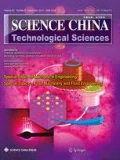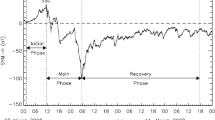Abstract
On January 21, 2015, a sharp increase of the solar wind dynamic pressure impacted the magnetosphere. The magnetopause moved inward to the region L< 8 without causing a geomagnetic storm. The flux of the relativistic electrons in the outer radiation belt decreased by half during this event based on the observations of the particle radiation monitor (PRM) of the fourth of the China-Brazil Earth Resource Satellites (CBERS-4). The flux remained low for approximately 11 d; it did not recover after a small magnetic storm on January 26 but after a small magnetic storm on February 2. The loss and recovery of the relativistic electrons during this event are investigated using the PRM data, medium- and high-energy electron observations of NOAA-15 and the Van Allen Probes, medium-energy electron observations of GOES-13, and wave observations of the Van Allen Probes. This study shows that the loss of energetic electrons in this event is related to magnetospheric compression. The chorus waves accelerate the medium-energy electrons, which causes the recovery of relativistic electrons. The Van Allen Probes detected strong chorus waves in the region L = 3–6 from January 21 to February 2. However, the flux of medium-energy electrons was low in the region. This implies that the long-lasting lack of recovery of the relativistic electrons after this event is due to the lack of the medium-energy “seed” electrons. The medium-energy electrons in the outer radiation belt may be a clue to predict the recovery of relativistic electrons.
Similar content being viewed by others
References
Selesnick R S, Baker D N, Jaynes A N, et al. Observations of the inner radiation belt: CRAND and trapped solar protons. J Geophys Res Space Phys, 2014, 119: 6541–6552
Zou H, Li C, Zong Q, et al. Short-term variations of the inner radiation belt in the South Atlantic anomaly. J Geophys Res Space Phys, 2015, 120: 4475–4486
Baker D N, Kanekal S G, Hoxie V C, et al. A long-lived relativistic electron storage ring embedded in Earth’s outer Van Allen belt. Science, 2013, 340: 186–190
Li X, Temerin M A. The electron radiation belt. Space Sci Rev, 2001, 95: 569–580
Shprits Y Y, Subbotin D, Drozdov A, et al. Unusual stable trapping of the ultrarelativistic electrons in the Van Allen radiation belts. Nat Phys, 2013, 9: 699–703
Zong Q G, Yuan C J, Wang Y F, et al. Dynamic variation and the fast acceleration of particles in Earth’s radiation belt. Sci China Earth Sci, 2013, 56: 1118–1140
Li L Y, Cao J B, Yang J Y, et al. Joint responses of geosynchronous magnetic field and relativistic electrons to external changes in solar wind dynamic pressure and interplanetary magnetic field. J Geophys Res Space Phys, 2013, 118: 1472–1482
Li L Y, Yu J, Cao J B, et al. Compression-amplified EMIC waves and their effects on relativistic electrons. Phys Plasmas, 2016, 23: 062116
Yu J, Li L Y, Cao J B, et al. The influences of solar wind pressure and interplanetary magnetic field on global magnetic field and outer radiation belt electrons. Geophys Res Lett, 2016, 43: 7319–7327
Yu J, Li L Y, Cao J B, et al. Multiple loss processes of relativistic electrons outside the heart of outer radiation belt during a storm sudden commencement. J Geophys Res Space Phys, 2015, 120: 10,275–10,288
Turner D L, Shprits Y, Hartinger M, et al. Explaining sudden losses of outer radiation belt electrons during geomagnetic storms. Nat Phys, 2012, 8: 208–212
Xiong Y, Xie L, Pu Z, et al. Responses of relativistic electron fluxes in the outer radiation belt to geomagnetic storms. J Geophys Res Space Phys, 2015, 120: 9513–9523
Yuan C J, Zong Q G. Dynamic variations of the outer radiation belt during magnetic storms for 1.5–6.0 MeV electrons. Sci China Tech Sci, 2011, 54: 431–440
Reeves G D, McAdams K L, Friedel R H W, et al. Acceleration and loss of relativistic electrons during geomagnetic storms. Geophys Res Lett, 2003, 30: 1529
Jaynes A N, Li X, Schiller Q G, et al. Evolution of relativistic outer belt electrons during an extended quiescent period. J Geophys Res Space Phys, 2014, 119: 9558–9566
Schiller Q, Li X, Blum L, et al. A nonstorm time enhancement of relativistic electrons in the outer radiation belt. Geophys Res Lett, 2014, 41: 7–12
Su Z, Xiao F, Zheng H, et al. Nonstorm time dynamics of electron radiation belts observed by the Van Allen Probes. Geophys Res Lett, 2014, 41: 229–235
Su Z, Xiao F, Zheng H, et al. CRRES observation and STEERB simulation of the 9. October 1990 electron radiation belt dropout event. Geophys Res Lett, 2011, 38: L06106
Baker D N. The occurrence of operational anomalies in spacecraft and their relationship to space weather. IEEE T Plasma Sci, 2000, 28: 2007–2016
Baker D N, Kanekal S, Blake J B, et al. Satellite anomalies linked to electron increase in the magnetosphere. Eos Trans AGU, 1994, 75: 401–405
Reeves G D, Spence H E, Henderson M G, et al. Electron acceleration in the heart of the Van Allen radiation belts. Science, 2013, 341: 991–994
Mozer F S, Agapitov O, Krasnoselskikh V, et al. Direct observation of radiation-belt electron acceleration from electron-volt energies to megavolts by nonlinear whistlers. Phys Rev Lett, 2014, 113: 035001
Schulz M, Lanzerotti L J. Particle diffusion in the radiation belts. Phys Chem Space, 1974, 7: 151
Thorne R M, Li W, Ni B, et al. Rapid local acceleration of relativistic radiation-belt electrons by magnetospheric chorus. Nature, 2013, 504: 411–414
Horne R B, Thorne R M, Glauert S A, et al. Timescale for radiation belt electron acceleration by whistler mode chorus waves. J Geophys Res, 2005, 110: A03225
Summers D, Ni B, Meredith N P. Timescales for radiation belt electron acceleration and loss due to resonant wave-particle interactions: 2. Evaluation for VLF chorus, ELF hiss, and electromagnetic ion cyclotron waves. J Geophys Res, 2007, 112: A04207
Jaynes A N, Baker D N, Singer H J, et al. Source and seed populations for relativistic electrons: Their roles in radiation belt changes. J Geophys Res Space Phys, 2015, 120: 7240–7254
Zong Q G, Zhou X Z, Wang Y F, et al. Energetic electron response to ULF waves induced by interplanetary shocks in the outer radiation belt. J Geophys Res, 2009, 114: A10204
Kim H J, Chan A A. Fully adiabatic changes in storm time relativistic electron fluxes. J Geophys Res, 1997, 102: 22107–22116
Li X, Baker D N, Temerin M, et al. Multisatellite observations of the outer zone electron variation during the November 3–4, 1993, magnetic storm. J Geophys Res, 1997, 102: 14123–14140
Kim K C, Lee D Y, Kim H J, et al. Numerical calculations of relativistic electron drift loss effect. J Geophys Res, 2008, 113: A09212
Matsumura C, Miyoshi Y, Seki K, et al. Outer radiation belt boundary location relative to the magnetopause: Implications for magnetopause shadowing. J Geophys Res, 2011, 116: A06212
Turner D L, Angelopoulos V, Li W, et al. Competing source and loss mechanisms due to wave-particle interactions in Earth’s outer radiation belt during the 30 September to 3 October 2012 geomagnetic storm. J Geophys Res Space Phys, 2014, 119: 1960–1979
Millan R M, Thorne R M. Review of radiation belt relativistic electron losses. J Atmos Sol-Terr Phys, 2007, 69: 362–377
Shprits Y Y, Subbotin D A, Meredith N P, et al. Review of modeling of losses and sources of relativistic electrons in the outer radiation belt II: Local acceleration and loss. J Atmos Sol-Terr Phys, 2008, 70: 1694–1713
Ni B, Bortnik J, Thorne R M, et al. Resonant scattering and resultant pitch angle evolution of relativistic electrons by plasmaspheric hiss. J Geophys Res Space Phys, 2013, 118: 7740–7751
Lorentzen K R, Looper M D, Blake J B. Relativistic electron microbursts during the GEM storms. Geophys Res Lett, 2001, 28: 2573–2576
Miyoshi Y, Sakaguchi K, Shiokawa K, et al. Precipitation of radiation belt electrons by EMIC waves, observed from ground and space. Geophys Res Lett, 2008, 35: L23101
Wang D D, Yuan Z G, Deng X H, et al. Compression-related EMIC waves drive relativistic electron precipitation. Sci China Tech Sci, 2014, 57: 2418–2425
Xiao Z, Bao S, Zhu W. Energetic particle detector on board “ZY-1” satellite. Acta Sci Natur Univ Pekin, 2003, 39: 361–369
Hao Y Q, Xiao Z, Zou H, et al. Energetic particle radiations measured by particle detector on board CBERS-1 satellite. Chin Sci Bull, 2007, 52: 665–670
Zou H, Xiao Z, Hao Y, et al. Analysis of the observation of particle detector inside ‘CBERS-1’ satellite under solar quiet conditions. Sci China Ser E, 2006, 49: 342–357
Evans D S, Greer M S. Polar Orbiting Environmental Satellite Space Environment monitor-2 Instrument Descriptions and Archive Data Documentation. Boulder: Space Environment Laboratory, 2004
GOES N Data Book. Prepared for National Aeronautics and Space Administration Goddard Space Flight Center Greenbelt, Maryland 20771. Pursuant to Contract NAS5-98069. Rev C 2009, CDRL PM-1-1-03
Blake J B, Carranza P A, Claudepierre S G, et al. The magnetic electron ion spectrometer (MagEIS) instruments aboard the radiation belt storm probes (RBSP) spacecraft. Space Sci Rev, 2013, 179: 383–421
Kletzing C A, Kurth W S, Acuna M, et al. The electric and magnetic field instrument suite and integrated science (EMFISIS) on RBSP. Space Sci Rev, 2013, 179: 127–181
Shue J H, Song P, Russell C T, et al. Magnetopause location under extreme solar wind conditions. J Geophys Res, 1998, 103: 17691–17700
Luo L, Zou H, Zong Q G, et al. Anti-proton contamination design of the imaging energetic electron spectrometer based on Geant4 simulation. Sci China Tech Sci, 2015, 58: 1385–1391
Zou H, Luo L, Li C F, et al. Angular response of ‘pin-hole’ imaging structure measured by collimated β source. Sci China Tech Sci, 2013, 56: 2675–2680
Author information
Authors and Affiliations
Corresponding author
Rights and permissions
About this article
Cite this article
Chen, Z., Chen, H., Li, Y. et al. Variations of the relativistic electron flux after a magnetospheric compression event. Sci. China Technol. Sci. 60, 638–647 (2017). https://doi.org/10.1007/s11431-016-9008-3
Received:
Accepted:
Published:
Issue Date:
DOI: https://doi.org/10.1007/s11431-016-9008-3




